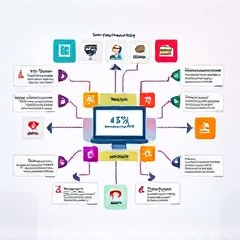Review of the book “Digital Marketing: Tools, Channels, Strategy and Principles of Digital Marketing” — Damir Sharifyanov
The author does not just retell hackneyed truths, but with enviable specificity analyzes:
- ROI in social networks for small businesses has grown over the past year
- Email marketing is not dead, but has evolved and brings leads cheaper than hype TikTok videos
In each chapter, Sharifyanov invites the reader backstage, where instead of theoretical slogans, there are real-life cases.
- Beginners find clear step-by-step instructions without a lot of water
- Experienced marketers find subtle nuances and "pitfalls" that are usually not mentioned at conferences
At the same time, the book is not one of those that you read with difficulty - the language is lively, ironic, and sometimes even cheeky, which is a rarity in a genre that often lapses into a dull handbook.
Yes, it's not without its rough edges: in some places, you want more in-depth analysis, sometimes criticism of popular trends is needed, but overall, it's a book worth keeping at hand if you're not just "in the know," but truly want to understand it.
Key Concepts and Their Analysis

In “Digital Marketing. Tools, Channels, Strategy, and Principles of Digital Marketing”, Damir Sharifyanov breaks down the entire arsenal of platforms — from ubiquitous targeting networks to the nuances of content strategies — without limiting himself to a routine enumeration, but instead shedding light on real miscalculations and discoveries from Russian businesses.
- The reader is not drowning in abstractions — here you will find numbers and facts.
- The author is not shy about insisting on the priority of analytics: without painstaking data collection and analysis, a marketer becomes a blind guide.
- Against this backdrop, his stance is particularly noticeable — not to follow the hype trends blindly, but to integrate them into fundamental processes, which sounds almost provocative in today's "eternal pursuit of novelty".
- This approach encourages not just reading, but arguing with the author, applying the tools to your own business, and keenly feeling that there is no room for empty promises here — only raw, honest digital marketing.
Who is the book for
If you came here looking for another "magic pill" to start advertising or dream of becoming an online promotion guru in half an hour, you will be disappointed - this book is clearly addressed to those who are ready to use their brains and roll up their sleeves.
- Beginners will find structured navigation through the jungle of online channels
- They will feel that marketing craft is not a lottery, but an engineering task
- For "life-beaten" specialists and business owners, the material opens up from a different angle
The author speaks as if to an equal, doesn't talk down or feed banalities, but demands discipline and attention to detail.
- University professors will also not be left without tools
- There's something to discuss in seminars, and something to argue about in the classroom
But most importantly, it's a guide for those who are not afraid to compare theory with harsh practice and agree that numbers don't lie, and a will to analyze can pull a company out of the marketing swamp.
About the author and his significance in marketing

Damir Sharifyanov is a practicing specialist in the field of digital marketing with over 15 years of experience. He is known as a speaker at professional conferences, author of educational courses, and consultant for small and medium-sized businesses. The main focus of his activity is applied marketing, understandable not only to professionals but also to entrepreneurs without special education.
The author actively advocates for the adaptation of Western digital practices to the realities of the Russian market and emphasizes the practical applicability of tools. His approach is based not on theory, but on real cases and working mechanics. Due to this, his works resonate with a wide audience - from freelancers and small business owners to students of specialized faculties.
Although he is not among the internationally recognized marketing gurus, his contribution to the popularization of an accessible and pragmatic digital approach in the Russian-speaking space is hard to overestimate. He makes digital marketing understandable "in simple terms", and it is for this that he has earned recognition in the professional community.
The place of the book in modern marketing literature
If you try to put this edition on a shelf with dozens of other “how to become successful on the internet in 7 steps” books, it will immediately stand out like a white crow at a party of grey ties. Unlike the endless retellings of Western case studies with captions “based on”, here you encounter live, rather than bookish, practice of Russian realities — the very nuances that turn beautiful theories into headaches when launching and budgeting.
Among the flow of similar guides, where everything comes down to checklists and infographics, this work is like a conversation with someone who is not afraid to admit:
- “yes, here we wasted 800 thousand in vain — and here's why”.
Thanks to such honesty and a fresh look at routine tasks, the book does not simply repeat banal truths, but honestly explains why even trendy tools, without adaptation to specifics, quickly turn into a waste of time and money. That's why it has taken the niche of a desktop book for those who don't want another recipe for “automated success”, but are looking for working solutions for real, not ideal, businesses.
| Criterion | Traditional approaches | Author's approach |
|---|---|---|
| Honesty | ||
| Practical application | ||
| No templates |
Relevance of the publication at the current moment

It is hard to overestimate the timeliness of this work: when the domestic market is tirelessly feverish from the next updates of algorithms, and the usual methods of promotion are crumbling like a house of cards - here finally appears a guide written not "based on" someone else's experience, but with an eye on the realities of today.
While other publications are quick to become outdated before they are even unpacked, the author cleverly responds to immediate challenges:
- breaks down fresh cases into components,
- doesn't get lost in abstractions, but gives visual schemes that work right now - not tomorrow, not yesterday.
This is not a textbook from a dusty shelf, but rather a road map that can be confidently followed, avoiding mines in the form of next "guaranteed" strategies. This approach is particularly valuable when betting on universal recipes has long outlived its usefulness, and betting on adaptation has become a matter of survival.
Fundamental Marketing Concepts

As you flip through the chapters, it becomes clear: the author doesn't resort to high-flown slogans, but breaks down the profession to its core — here, the emphasis is clearly on what really keeps any campaign afloat. At its core is a clear hierarchy:
- Understanding the target audience (not "anyone who's interested", but segments with real portraits and pain points)
- Competent construction of a sales funnel, where each stage filters out the unnecessary and retains the necessary.
The pages are dotted with facts: many companies lose leads at the initial contact stage — and this is not an abstract threat, but a reality confirmed by recent research, which the author takes the trouble to cite. Instead of a dull enumeration of terms, there's an analysis of why CPA is more important than likes, and ROI is not just a formula, but a litmus test of effectiveness that is often forgotten when standing at the whiteboard in a meeting room.
This approach not only structures chaos, but also makes you wonder: how many of the truisms do we actually apply, and how many do we store in our heads like unnecessary instructions for household appliances.
Innovative ideas and modern trends
Here, at the intersection of theory and live experience, the author is not afraid to bring to light the latest industry tricks: instead of the dust of centuries-old monuments — a fresh wind from TikTok and Telegram, where one successful challenge can shoot a brand to the top overnight.
- Special attention is paid to automation: from trigger mailings to on-the-fly segmentation — not just in theory, but with an analysis of the rakes that even market giants step on
- The author is not chasing hype for the sake of hype: he meticulously analyzes what distinguishes artificial intelligence built into Meta's advertising cabinets from manual optimizations
- How not to go into the red on this "game with the machine" if the budget doesn't allow for broad gestures.
- A chill of healthy skepticism: here they don't claim that chatbots will save business, but honestly show where they turn into a black hole for the budget.
- This approach opens your eyes to the real cost of "innovations", but also angers — because you have to admit: much of what's fashionable today risks being a dummy tomorrow.
Applicability of concepts in modern business
To ignore Damir Sharifyanov's "Digital Marketing" is like entering the online space with a torch, hoping to light your way in the era of neural networks and big data: it's reckless and naive. In the book, concepts are not just listed - they are embedded in reality, like a chip in a smartphone: without unnecessary theorizing, straight to the point.
- One striking example is a detailed analysis of a campaign in the context of omnichannel promotion, where the author shows how synchronization between email, push, and targeting significantly improved efficiency.
- This is not an abstract discussion about funnels, but a guide to building a digital business that exists here and now.
- The emphasis on the need for adapting strategies to the algorithmic thinking of platforms is particularly memorable: if you don't adapt, you won't sell.
- Sharifyanov doesn't get bogged down in the details, but nor does he simplify things to the level of "turn on the ad - get a client." His approach is a scalpel, not a hammer: precise, causing little damage, but accomplishing a lot.
- In conditions where marketing becomes a game not of survival, but of outpacing, such a methodology is not just applicable, but vital.
| Parameter | Digital Marketing | Traditional Marketing |
|---|---|---|
| Efficiency | High | Low |
| Adaptability | Flexible | Rigid |
| Algorithmic thinking | Necessary | Not required |
Case studies and examples from real business
The special value of the material lies in its ability to speak the language of those who do business with their hands, not just slogans.
The book provides various examples and case studies that illustrate how digital marketing tools and strategies are applied in real business. This helps to understand how theoretical concepts are transformed into practical results.
The given examples from real practice help to see how various digital tools are applied in practice. Every business, regardless of size, can benefit from implementing the right digital strategies. It's essential to remember that success comes not only from using tools but also from a deep understanding of the audience's needs and continuous improvement of marketing practices.
Strengths of the publication
What really holds your attention is the ultimate specificity with which the author dissects applied mechanics: not vague advice like "work with your audience," but a detailed analysis of exactly how they "worked" and who made mistakes where.
The structure of the material deserves special mention: without academic tediousness, but also without superficial simplification — clearly, concisely, to the point.
The book doesn't offer "magic pills", but provides tools that can pull a project out of manual management and chaotic advertising. This is its key strength: it doesn't teach you how you should do it, it shows how it was done, what didn't work, and what ultimately produced results.
- Ultimate specificity in applied mechanics
- Clear structure of the material without tediousness
- Practical examples from real life
- Tools for effective project management
Critical analysis
Damir Sharifyanov's book is distinguished by its practical focus and the desire to adapt digital marketing to the realities of Russian business. This makes it potentially useful for novice specialists and small business owners. However, upon closer reading, several significant limitations become apparent:
- Unverified or outdated data. The author provides statistics without references to sources or refers to data from 2020–2021, which may be irrelevant in the rapidly changing digital environment. This reduces the credibility of the book's factual basis.
- Insufficient depth on several topics. Many sections — such as SEO, analytics, or working with funnels — are presented in a simplified manner. For beginners, this may be a plus, but for mid-level marketers or business owners seeking more in-depth analysis, the material may be insufficient.
- Mixing genres. The author periodically shifts from a business tone to emotional reasoning or motivational statements. This reduces the structure of the narrative and makes the book less cohesive in style.
- Lack of a systematic approach. Although the book covers a wide range of topics, the connection between them is sometimes weak. There is no clear logic for building a strategy: the tools are listed, but not built into a single model or step-by-step implementation plan.
As a result, despite the energetic presentation and broad coverage of topics, the book “Digital Marketing” leaves the impression of an information “digest” without deep analysis or a clear structural framework. It can inspire the first steps, but it does not replace fundamental guides to building a marketing strategy in a digital environment.
Tools and techniques for practical use
On the pages where the author analyzes applied mechanisms, a noble intention to simplify the complex is felt - and he has really succeeded in this. The main digital levers are described, from email funnels to behavioral analytics in social networks, and it seems that you can just take and implement them. But, alas, this harmonious construction lacks the most important thing - a sense of real implementation. It's like looking at a shiny control panel without hearing the engine humming.
- there is no step-by-step setup scenario
- there are no real implementation constraints
- as if all companies have the same budget
- the same resources
- the same obedient audience
For example, the A/B testing tool is mentioned, but without specific conditions:
- what traffic
- how much time
- what was compared
- what were the boundary values
As a result, you read it, and it seems useful, but in practice, you're like being in a labyrinth without a map. You don't just want a set of tools, but a workshop that shows how to work with these tools really, with dirt under your nails and creaking mechanisms.
| Tool | Description | Application |
|---|---|---|
| Email funnels | Email marketing automation | Attracting and retaining customers |
| A/B testing | Comparing two versions | Content optimization |
| Behavioral analytics | Analyzing user behavior | Marketing setup |
Popularity of the current publication

You can't help but wonder: how did a publication so neatly tailored to theoretical templates manage to become a frequent guest on the desks of students, junior marketers, and even freelancers who are just starting to grasp the digital showcase?
- Demand for the book is fueled not so much by its internal content as by external circumstances:
- a shortage of accessible Russian-language literature,
- an illusion of systematicity,
- active self-promotion by the author on social media.
- Reviews on Ozon and LitRes vary between 4.3 and 4.7 stars, but the number of reviews is modest, and upon closer inspection, disappointment is evident in the comments:
- "well-structured but superficial",
- "expected more in terms of examples".
It creates the impression that the book became popular not because it solves a problem, but because it promises to solve it. It's like buying a toolbox and then realizing that the instructions for it are another book that... doesn't exist.
Other works by the author
Against this background, it becomes especially curious to look at other works by the author — and here, alas, the situation resembles a buffet in a budget hotel: it seems like there's a choice, but there's nothing to reach for a second time.
- Main articles on specialized platforms
- Short guides for internal courses
- Outline the contours of the topic
- Practically no work with numbers
- No analysis of real cases
- Lists of tools
- Vague advice like "run A/B tests"
This is not so much educational content as a set of theses that, apparently, are supposed to lead the reader to think "something needs to be googled."
Author's presentation: Simple, devoid of tediousness, sometimes even friendly — but behind this accessibility often hides poverty of content.
If the current book at least tries to create an illusion of a systematic approach, then in other works, there isn't even an attempt.
The impression is that the author is in a hurry to establish themselves as a guide to the digital space, without waiting until they have completed the journey themselves.
Comparison with other works by the author
If we try to consider the author's evolution, it becomes obvious: the current work is the first truly well-structured project, not just another hastily compiled cheat sheet for internal use.
Unlike the early materials, where everything was limited to lists of tools and routine recommendations, here the author finally took a more ambitious approach - although not without some roughness.
His previous works were more like methodological notes for first-year students:
- Superficial
- Fragmentary
- With a feeling that the text was written between a client meeting and morning coffee
They lacked real-life cases, in-depth analysis, and the sense that behind the words lies experience tested in practice.
In the current book, despite the overload of terminology and excessive charm of the PowerPoint approach, one can finally feel an attempt to link tools and strategy into a coherent system.
This is not a sudden growth - rather, it's a transition from a draft to the first sketch of something bigger.
| Criterion | Early works | Current book |
|---|---|---|
| Depth of analysis | Superficial | Connection between tools and strategy |
| Examples | No real-life cases | Support from practical experience |
| Structure | Routine recommendations | Well-structured project |
Similar literature by other authors
Against the backdrop of other publications that have flooded the shelves of the digital sales section — be it Igor Mann's "Marketing on 100%" or Denis Kaplunov's "Content, Marketing, and Rock-n-Roll" — the work under consideration is perceived not as another retelling of Western blogs, but as an attempt to build its own coordinate system.
- Mann's work is clear and well-organized, but with a touch of office casuistry and without the living, nervous pulse of practice.
- Kaplunov's work has style and charisma, but at some point, you start to feel like you're reading motivational stand-up instead of a manual.
- Here, despite excessive academicism and an obvious love for abbreviations, there's a desire to move away from banal copying.
- The conversation is held on equal terms — not from above, not secretly, but with an attempt to truly explain why, how, and in what sequence to apply the tools.
- This doesn't mean the book is flawless — it's overloaded in places and requires patience from the reader.
- Against the backdrop of "useful advice" like "create content and wait for traffic" — this is already a world apart.
Damir Sharifyanov's book "Digital Marketing" offers a fresh look at the world of digital marketing, focusing on practical cases and real data rather than overused theories. The author isn't afraid to criticize popular trends and emphasizes analytics and specific tools that actually work.
However, despite numerous success stories, the book lacks in-depth criticism and analysis of failures, which limits its practical value. Overall, it's a useful resource for those willing not just to study but to apply strategic approaches in practice.
